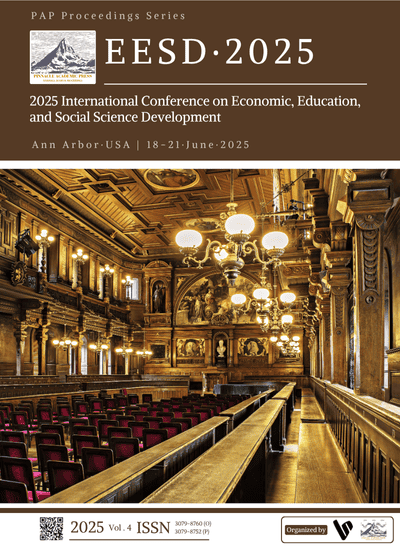Empirical Analysis and Factors Influencing the Structural Adjustment of Tea Industry in Enshi
DOI:
https://doi.org/10.71222/3h6k7h19Keywords:
Tea industry, industrial restructuring, EnshiAbstract
Since the reform and opening up, the tea industry in Enshi region has developed rapidly. The role and status of the Enshi Prefecture tea industry have been significantly enhanced both within the national tea industry and in Hubei Province's rural economy. With the new round of comprehensive adjustment of China's entire agricultural industrial structure and the change of the macroeconomic environment caused by China's entry into a new historical development stage, the development of Enshizhou tea industry is facing new opportunities and challenges. In order to maintain the strong growth momentum, Enshi tea industry needs to further optimize the structure, through strengthening institutional innovation and technological innovation, as well as the development of local tea production to adapt to a people-centered management system, in order to cultivate new growth drivers and promote further sustainable development. This paper is based on relevant data from the tea industry in Enshi Prefecture from 2000 to 2021 to establish a time series model, explore the impact of Enshizhou tea industry on agricultural output value, and finally put forward policy proposals to optimize the tea industry structure in Enshi region from different angles, such as optimized resource allocation and sustainable development.
References
1. H. Long and Y. Liu, "Rural restructuring in China," J. Rural Stud., vol. 47, pp. 387–391, 2016, doi: 10.1016/j.jrurstud.2016.07.028.
2. S.-Y. Pan, H. Gao, Y. Yang, J. Ma, H. Wang, S. Zhang, et al., "Tea and tea drinking: China’s outstanding contributions to the mankind," Chin. Med., vol. 17, no. 1, p. 27, 2022, doi: 10.1186/s13020-022-00571-1.
3. Z. Zheng, B. Yan, and W. Wang, "Research on the paths of rural revitalization in ethnic regions from the perspective of tea-tourism integration: A case study in Wujiatai Village, Enshi Prefecture, Hubei Province," Adv. Educ. Humanit. Soc. Sci. Res., vol. 1, no. 3, p. 195, 2022, doi: 10.56028/aehssr.3.1.195.
4. Q. Xu, Y. Zhao, M. Liu, J. Wang, H. Li, L. Zhang, et al., "Economic, environmental, and emergy analysis of China's green tea production," Sustain. Prod. Consum., vol. 28, pp. 269–280, 2021, doi: 10.1016/j.spc.2021.04.019.
5. Q. Wu, C. Sun, and J. Yang, "Economic analysis of the change of tea production layout in China," J. Phys.: Conf. Ser., vol. 1629, no. 1, p. 012048, 2020, doi: 10.1088/1742-6596/1629/1/012048.
6. R. Firyanto, B. Setiawan, E. Rohendi, A. Iskandar, R. Rusdiana, A. Suryadi, et al., "Utilization of tea tree branches as a source of thermal energy," Key Eng. Mater., vol. 849, pp. 8–13, 2020, doi: 10.4028/www.scientific.net/KEM.849.8.
7. F. Yihan, "Research on the impact of agricultural industrial structure adjustment on agricultural labor productivity based on trade channels," in Proc. ERMBFE, 2019.
8. F. Zhou, W. Li, J. Zhang, L. Wang, Y. Yang, M. Chen, et al., "Analysis on the influencing factors of rural infrastructure in China," Agriculture, vol. 13, no. 5, p. 986, 2023, doi: 10.3390/agriculture13050986.
9. L. Ma and Y. Li, "Research on agricultural industrial structure optimization and town development in 'Thirteen Five' period," in Proc. Int. Conf. Econ. Manag. Educ. Technol., 2016, doi: 10.2991/icemet-16.2016.329.
10. D. Duan, "Study on sustainable agricultural structure optimization method based on multiobjective optimization algorithm," Comput. Intell. Neurosci., vol. 2022, art. no. 5850684, 2022, doi: 10.1155/2022/5850684.
11. Y. Zhao, B. Liu, H. Yang, Y. Li, Z. Chen, S. Wang, et al., "Adapting tea production to climate change under rapid economic development in China from 1987 to 2017," Agronomy, vol. 12, no. 12, p. 3192, 2022, doi: 10.3390/agronomy12123192.
12. H. Pan, Y. Liu, and H. Gao, "Impact of agricultural industrial structure adjustment on energy conservation and income growth in Western China: A statistical study," Ann. Oper. Res., vol. 228, no. 1, pp. 23–33, 2015, doi: 10.1007/s10479-012-1291-2.
13. R. Gunathilaka and G. A. Tularam, "The tea industry and a review of its price modelling in major tea producing countries," J. Manag. Strategy, vol. 7, no. 1, pp. 34–39, 2016, doi: 10.5430/jms.v7n1p21.
14. J. Liu, X. Wang, S. Zhang, H. Chen, Y. Li, R. Zhao, et al., "Study the effect of industrial structure optimization on urban land-use efficiency in China," Land Use Policy, vol. 105, p. 105390, 2021, doi: 10.1016/j.landusepol.2021.105390.
15. R. I. D. Harris, "Testing for unit roots using the augmented Dickey-Fuller test: Some issues relating to the size, power and the lag structure of the test," Econ. Lett., vol. 38, no. 4, pp. 381–386, 1992, doi: 10.1016/0165-1765(92)90022-Q.
Downloads
Published
Issue
Section
License
Copyright (c) 2025 Wenjin Xiang (Author)

This work is licensed under a Creative Commons Attribution 4.0 International License.



